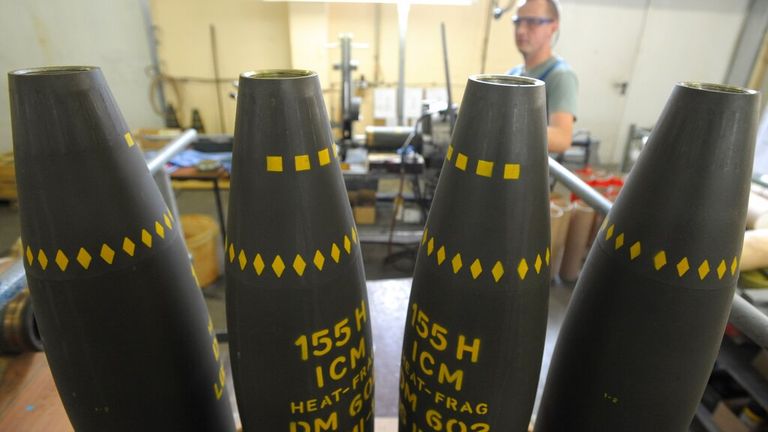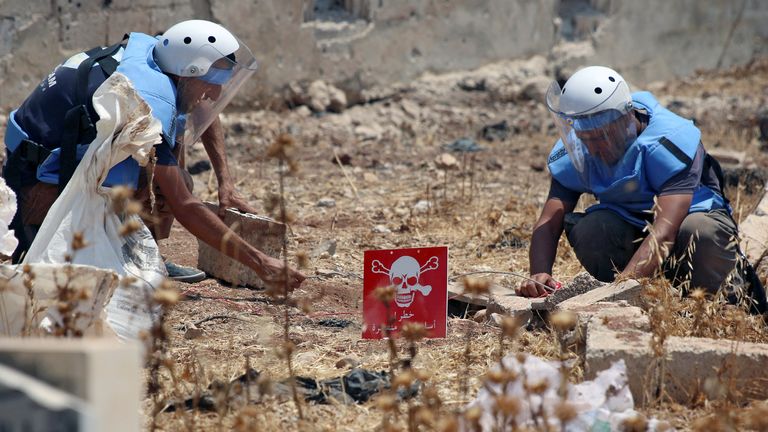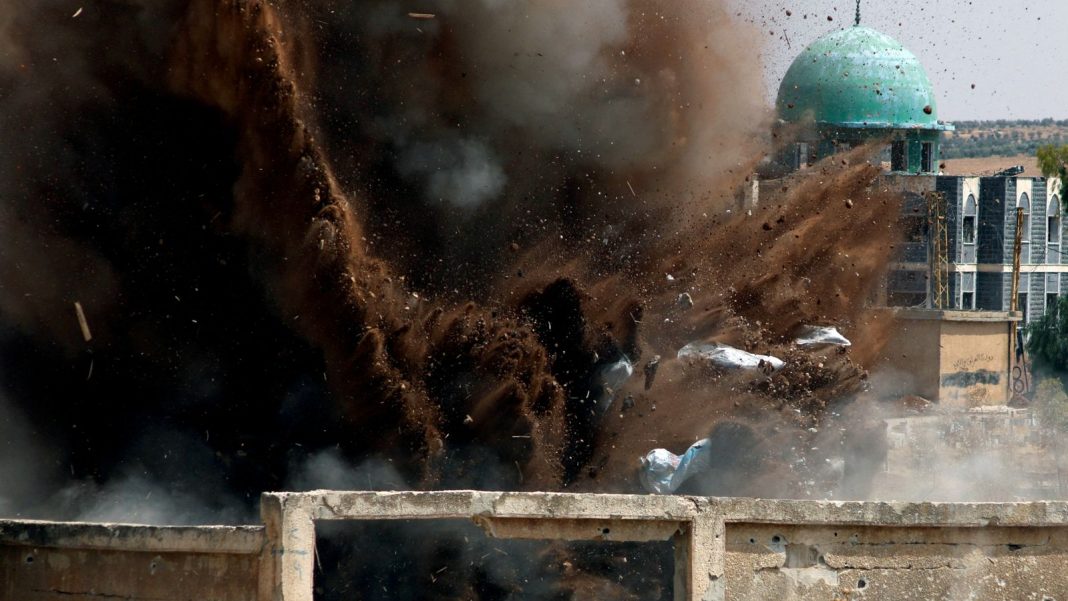President Biden has agreed to give Ukraine controversial cluster munitions to use against Russian troops.
The weapon detonates in the air and releases “bomblets” that scatter over a large area.
Opponents say they kill indiscriminately and that some of the smaller munitions can fail to detonate, posing a long-term risk to civilians.
Ukraine war latest: Deadly blast at Russian explosives factory
US officials said the cluster bombs it will provide have a low “dud rate” of under 2.35% to minimise the risk.
President Biden called it a “difficult decision” but said he had to act as “the Ukrainians are running out of ammunition”.
He told CNN the cluster bombs were being sent as a “transition period” until it can supply more standard 155mm artillery.
Colin Kahl, under secretary of defense for policy, said “hundreds of thousands” were available but refused to state how many would initially be provided.
He said Russia had been using older cluster munitions with a dud rate of 30-40% since the start of the war.
Analysis: US cluster bombs deal is clear signal war is not going well for Ukraine
A Ukrainian serviceman with a defused cluster bomb from a Russian missile
Ukraine is said to have given written assurances not to use them in populated areas, to map where they are used, and committed to a post-war clean-up.
The US put off the decision “as long as we could” due to the risk to civilians, said Jake Sullivan, Mr Biden’s national security adviser.
But he said there was “a massive risk of civilian harm” if Russia takes more territory because Ukraine doesn’t have enough artillery.
Ukrainian presidential adviser Mykhailo Podolyak said cluster munitions could have an “extraordinary psycho-emotional impact” on demoralised Russian troops.
More than 100 countries are signed up to a convention against the use and manufacture of cluster bombs, but the US, Russia and Ukraine are not part of it.
“We’re not signatories to that agreement, but it took me a while to be convinced to do it,” President Biden told CNN.
He said he’d followed the recommendation of US defence officials.

Cluster munition shells being dismantled in Germany in 2009. Pic: AP
NATO Secretary-General Jens Stoltenberg said the alliance had no position on the issue and that it was for “individual allies… to make those decisions”.
However, the United Nations has urged both sides not to use them.
Read more:
The training facility where Wagner Group fighters ‘would be welcome’
Wagner troops leave Central African Republic after ‘refusing contracts with Russia’
UN human rights office spokesperson Marta Hurtado said “the use of such munitions should stop immediately and not be used in any place”.
The International Red Cross said cluster munitions “cause significant numbers of preventable civilian casualties”.
US risks the moral high ground – but the weapon could prove decisive on the ground
By supplying the weapon, there is a clear risk to civilians, not now necessarily, but in the future. The legacy of unexploded cluster bomblets is evident on former battlefields globally.
America also risks losing the moral high ground against Russia by supplying a weapon banned by much of the world.
So why supply it? Well, the facts on the ground are not in Ukraine’s favour. The transfer is a clear signal that the war is not going well for Ukraine.
The so-called spring offensive did not materialise in the spring and looks set to falter through the summer too.
Ukraine is fast running out of more conventional artillery, with supply stocks in America and elsewhere running low. A ‘bridge of supply’ is necessary.
America holds a vast dormant stockpile of cluster munitions. They could shift the momentum significantly on the ground, wiping out heavily dug in Russian troops.
American officials are accepting that a legacy of civilian casualties is a risk but counter it by arguing that more civilians are at risk by allowing Russia to occupy Ukrainian land.
The munitions would be used by Ukraine on occupied Ukrainian soil. The risk to civilians would be owned by Ukraine. The onus would be on Ukraine, with a pledge of American help, to clear the unexploded mines when the war comes to an end.
The announcement is part of a multi-million dollar tranche of new weaponry which is an attempt by the Biden administration to future proof the conflict; to give Ukraine the weapons it needs now in case domestic political circumstances change in the next 18 months.
American politics is in flux. There is no guarantee of open-ended support for Ukraine.
Oleksandra Ustinova, a member of Ukraine’s parliament, is one of those supporting the weapon’s use.
She said troops already had to disable mines when they regain territory and could catch any unexploded bomblets as part of that.
“We will have to de-mine anyway, but it’s better to have this capability,” she said.
Sky defence analyst Sean Bell said Ukraine had to make a judgement about “the benefits of these weapons, which could provide a decisive capability in this war, versus the risk of the legacy they’re going to inherit of having to clear these up”.

People clearing cluster munitions in Syria in 2017
The last large-scale US use of the weapon was in Iraq in 2003.
However, Human Rights Watch estimates the American-led coalition also used 1,500 cluster bombs in the first three years of the Afghanistan war.
The cluster bombs being sent to Ukraine are part of another tranche of weaponry and ammunition that the US says brings its total arms contribution to $41.3bn (£32bn).







